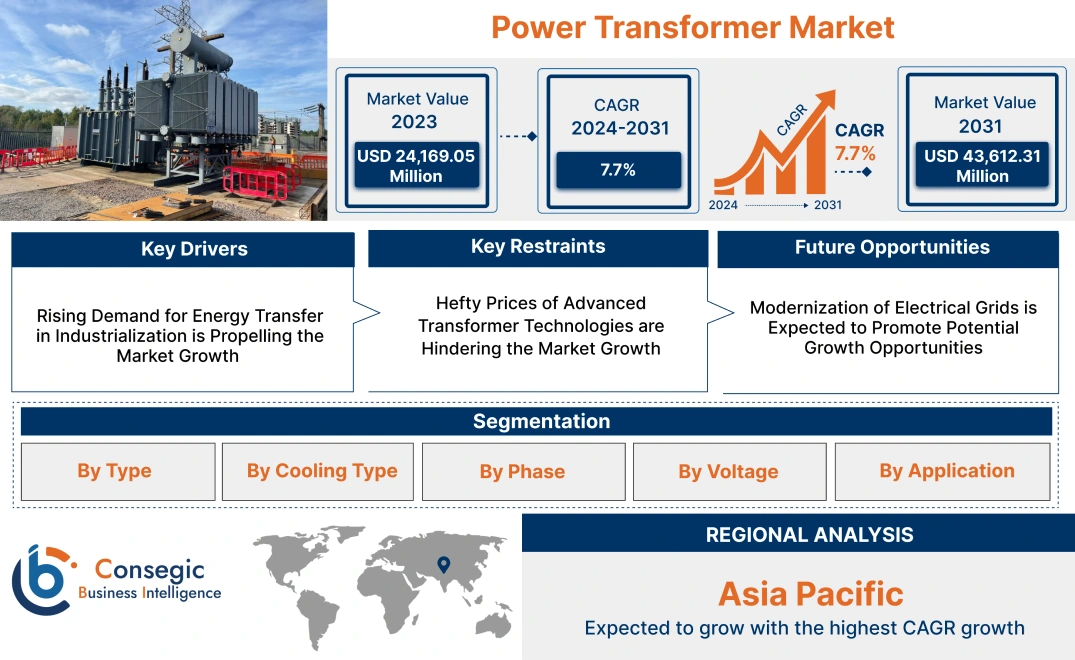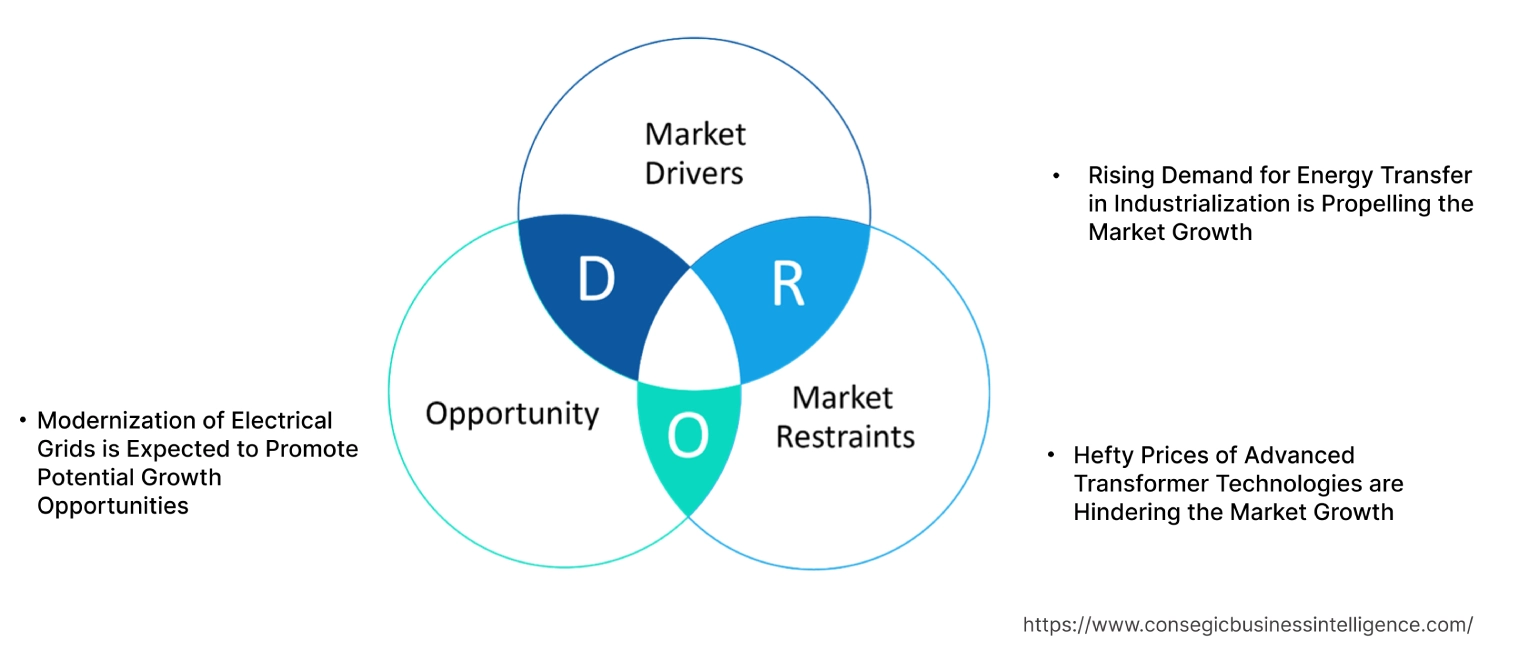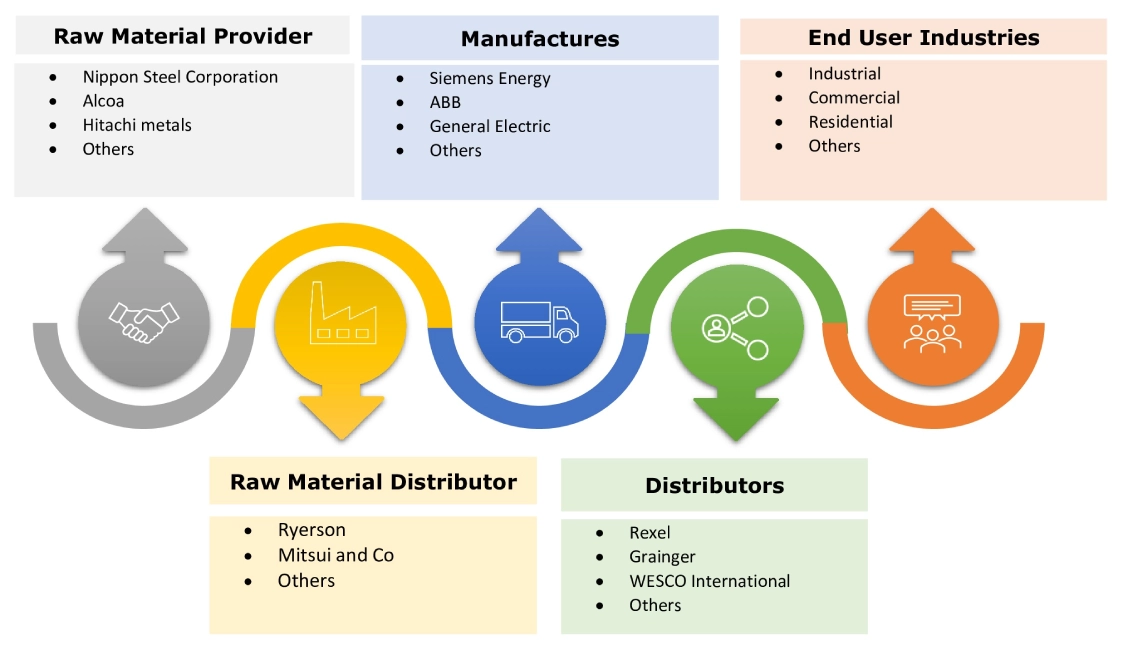- Summary
- Table Of Content
- Methodology
Power Transformer Market Size:
The Power Transformer Market size is estimated to reach over USD 43,612.31 Million by 2031 from a value of USD 24,169.05 Million in 2023 and is projected to grow by USD 25,589.22 Million in 2024, growing at a CAGR of 7.7% from 2024 to 2031.
Power Transformer Market Scope & Overview:
A power transformer is an electrical device in the electrical power system that enables the efficient transfer of electrical energy between different voltage levels without altering the frequency. It operates on the principle of electromagnetic induction and is designed to either increase or decrease the voltage in the power transmission network. Additionally, it ensures that electricity is transmitted over long distances with minimal losses and then safely used by end consumers. These transformers feature a core made of laminated steel sheets to reduce energy loss and windings of copper or aluminum that facilitate the transfer of electric current. Moreover, these transformers are crucial for integrating renewable energy sources, making them indispensable for reliable and efficient electricity distribution. The aforementioned features are major determinants for increasing their deployment in residential, commercial, industrial, and other applications.
Power Transformer Market Insights:
Key Drivers:
Rising Demand for Energy Transfer in Industrialization is Propelling the Market Growth
Industries depend on power transformers to ensure a reliable and stable electricity supply, which is crucial for their operations. As industries expand and new manufacturing facilities are established, they require substantial amounts of electric power to operate effectively. This surge in industrial activities drives the need for robust power infrastructure, including power transformers to manage and distribute high voltage and large power loads efficiently. Additionally, existing facilities are undergoing significant upgrades to enhance efficiency and increase production capabilities. This modernization often involves installing advanced transformers to handle higher loads and ensure a stable and reliable power supply. Furthermore, the integration of new technologies within industrial processes including automation and advanced manufacturing techniques alters energy consumption patterns, needing sophisticated power transformers.
- In April 2021, Siemens introduced Siprotec 5 power system protection to cater to the needs of industrial applications. It is designed to enhance the reliability and efficiency of transformer operations. It provides real-time monitoring, protection, and automated power systems, helping to prevent potential faults and improve the energy transition.
Therefore, the growing demand driven by industrialization is a pivotal factor fueling the growth of the global power transformer market.
Key Restraints :
Hefty Prices of Advanced Transformer Technologies are Hindering the Market Growth
Advanced transformers equipped with digital monitoring, high-efficiency components, and smart grid capabilities typically require a higher initial investment. This cost barrier is a significant impediment for utilities, industrial operators, and infrastructure developers particularly in emerging markets where budget constraints are more pronounced. Additionally, the technology and advanced features in modern transformers lead to higher maintenance and upgrade costs. Ensuring that these components remain in optimal working condition requires specialized skills and more frequent servicing, adding up to the overall cost. Hence, the market analysis depicts that the high cost of advanced transformer technologies is the key restraint of the power transformer market demand.
Future Opportunities :
Modernization of Electrical Grids is Expected to Promote Potential Growth Opportunities
Modernization of electrical grids involves integrating smart grid technologies, enhancing grid stability, and improving the management of energy resources. This enhancement often requires replacing outdated transformers with new, more efficient models that handle higher loads and provide better performance. Advanced transformers equipped with digital monitoring and control systems are crucial for supporting these upgrades, as they enable utilities to manage energy flows effectively, reduce downtime, and integrate renewable energy sources. Additionally, smart grids and advanced energy management systems drive the need for transformers that support new functionalities including real-time monitoring, automated fault detection, and dynamic load management.
- In August 2024, Hitachi Energy Ltd introduced Grid-enSure to stabilize power systems by strengthening transmission and managing frequency variations. This solution portfolio includes advanced power transformer and grid control systems designed to enhance stability, efficiency, and integration capabilities to support grid modernization efforts.
Consequently, the analysis shows that the modernized grids offer reliable and efficient energy transition, proliferating the power transformer market opportunities.
Power Transformer Market Segmental Analysis :
By Type:
Based on type the market is bifurcated into step-up transformers and step-down transformers.
Trends in the Type:
- Advances in materials and engineering are leading to more compact and modular step-up transformers. These designs are especially beneficial for installations in space-constrained environments including offshore wind farms or remote solar power stations.
- There is an increasing tendency towards emphasis on energy-efficient designs and the use of environmentally friendly materials in step-down transformers. This includes innovations that include low-loss core materials and the use of ester-based insulating fluids that have a lower environmental impact.
The step-down accounted for the largest revenue share in 2023 and is anticipated to register the fastest CAGR during the forecast period.
- A step-down transformer is a type of electrical transformer used to reduce the voltage from a higher level to a lower level. It operates on the principle of electromagnetic induction.
- It consists of two or more wire coils known as primary and secondary windings which are wrapped around a core.
- Additionally, these transformers ensure that electricity is safe to use, and help in maintaining energy efficiency by minimizing losses and optimizing the delivery of electrical power.
- In September 2023, Lasron Electronics introduced the MT-BBT-504D-480D-3P-43.8A buck and boost step-down transformer. It features a secondary voltage of 480V AC and cores made of cold-rolled silicon steel lamination. It provides energy efficiency and optimizes the power.
- Thus, segmental analysis shows that the necessity for step-down transformers in power distribution is boosting the global power transformer market growth.
By Cooling Type:
Based on cooling type the market is bifurcated into oil-immersed transformers and dry-type transformers.
Trends in the Cooling Type:
- There is a growing tendency towards using environmentally friendly insulation oil including ester-based fluids in oil-immersed transformers. These fluids are biodegradable and have a lower environmental impact.
- Dry-type transformers are increasingly preferred for use in urban environments and confined spaces due to their safety advantages and lack of flammable liquids. They are well suited for applications in commercial buildings, high-rise structures, and indoor installations where space is a critical concern.
The oil-immersed transformer accounted for the largest revenue share in the year 2023.
- The oil-immersed transformer is a type where internal components including the winding and core, are submerged in insulating oil which helps in cooling and electrical insulation.
- These transformers are well known for their superior cooling capabilities, allowing them to handle power ratings and loads.
- Additionally, the use of oil as an insulating and cooling medium provides effective thermal management and high reliability.
- In September 2022, Elsewedy Electric launched a transformers plant as a part of the second phase of the USD 50 million Complex. It is built with a production capacity of 2500 oil-immersed distribution transformers. These transformers feature enhanced cooling systems and environmentally friendly insulating oils to improve performance and sustainability.
- Therefore, analysis of this segment portrays that the oil-immersed transformers due to their effective cooling and insulation properties, drive the power transformer market trend.
The dry-type transformer is anticipated to register the fastest CAGR during the forecast period.
- Dry-type transformers are power transformers that use air or non-flammable insulating materials instead of liquid (such as oil) for cooling and insulation.
- The cooling of dry-type transformers relies on air circulation. They typically have ventilation openings or fans to facilitate airflow around the transformer, which helps to dissipate the heat generated during operation.
- Innovations including improved epoxy resin systems and enhanced heat dissipation mechanisms in dry-type cooling provide efficiency and operational lifespan.
- Additionally, these are increasingly being integrated into renewable energy systems, data centers, and commercial buildings where environmental impact and sustainability are key considerations.
- In April 2022, Siemens Energy launched a dry-type single-phase transformer for pole application. It is particularly designed to cater technological requirements of the American grid, this distribution transformer provides a reliable and sustainable alternative to oil-filled transformers. These transformers feature cast-resin designs with advanced cooling technologies and high-performance insulation materials. It ensures reliability, and safety, the ability to handle high overloads, and reduces environmental risks.
- Consequently, the increasing focus on safety, sustainability, and efficient cooling offered by dry-type transformers is anticipated to boost the power transformer market share.
By Phase:
Based on phase, the market is bifurcated into single-phase transformers and three-phase transformers.
Trends in the Phase:
- There is a growing drift toward improving the efficiency and reliability of single-phase transformers used in residential and small commercial applications. Innovations in core materials and winding technologies are leading to reduced energy losses and better performance in these lower-power applications.
- Three-phase transformers are seeing a tendency towards incorporating advanced cooling and insulation technologies in three-phase transformers. Innovations such as improved cooling systems and enhanced insulation materials are helping to increase the efficiency, reliability, and lifespan of these transformers in applications.
The three-phase transformer accounted for the largest revenue share in the year 2023 and is anticipated to register the fastest CAGR during the forecast period.
- Three-phase power is a type of electrical power distribution that uses three separate alternating currents (AC) to deliver electricity.
- The system consists of three conductors (or phases) and a neutral wire. Each phase carries an alternating current, and the three-phase power system is designed to ensure a continuous and stable supply of electricity.
- It provides balanced load-reducing voltage drops, ensures more stable and reliable power delivery, and high efficiency for transmitting.
- For instance, Elhand's ET3S is a three-phase transformer with power between 40 and 1600 kVA. These transformers feature advanced insulation, the ability to handle high power requirements, maintain stable performance, providing efficient and reliable power distribution.
- Hence, three-phase is an efficient and reliable method for delivering electrical power, fueling the power transformer market trend.
By Voltage:
Based on voltage, the market is segmented into low voltage, medium voltage, and high voltage.
Trends in the Voltage:
- There is a growing trend toward designing more compact and lightweight low-voltage transformers to meet space constraints in residential and commercial buildings. This trend is driven by the need for efficient power distribution in smaller and more constrained environments.
- High voltage transformers are essential for integrating renewable energy sources into the grid. There is a trend towards developing transformers with advanced features to handle the high-power outputs from wind and solar farms and to support grid stability.
The medium voltage accounted for the largest revenue share of 47.22% in 2023.
- Medium voltage transformers range from 1kV to 69kV, designed to provide reliable and efficient power distribution.
- These transformers offer a balance between cost and power handling capabilities. They are versatile and suitable for a range of applications, making them a preferred choice for many power distribution scenarios.
- Additionally, these are widely used in urban infrastructure for distributing electricity within cities and industrial facilities, where moderate power loads are common.
- For instance, Eaton Corporation unveiled the Power Xpert UX medium voltage transformer series. It is designed for high efficiency and reliability in critical infrastructure applications with cast-resin insulation. These transformers incorporate advanced materials to enhance their operational lifespan and performance in challenging environments.
- Therefore, the reliability and versatility of medium voltage transformers are propelling the power transformer market demand.
The high-voltage transformer is anticipated to register the fastest CAGR during the forecast period.
- The high voltage transformer ranges from 69kV and above, crucial for efficient long-distance power transmission, making them essential for modernizing and expanding power grids.
- The integration of renewable energy sources like wind and solar power often requires high-voltage transformers.
- Additionally, the development of super grids and advanced power distribution networks necessitates the use of high-voltage transformers.
- Moreover, ongoing advancements in high-voltage transformer technology, such as improved insulation materials and advanced cooling systems, are enhancing their performance and reliability.
- For instance, Hitachi Energy's Capacitor Voltage Transformer TYD with high voltage ranging from 126kV to 550kV. It provides consistent quality to ensure long-term reliability and performance. It is designed for various applications including revenue metering, protective relaying, system control, and indication of power flow.
- Overall, the combination of these factors of high voltage transformers is anticipated to boost the power transformer market opportunities.
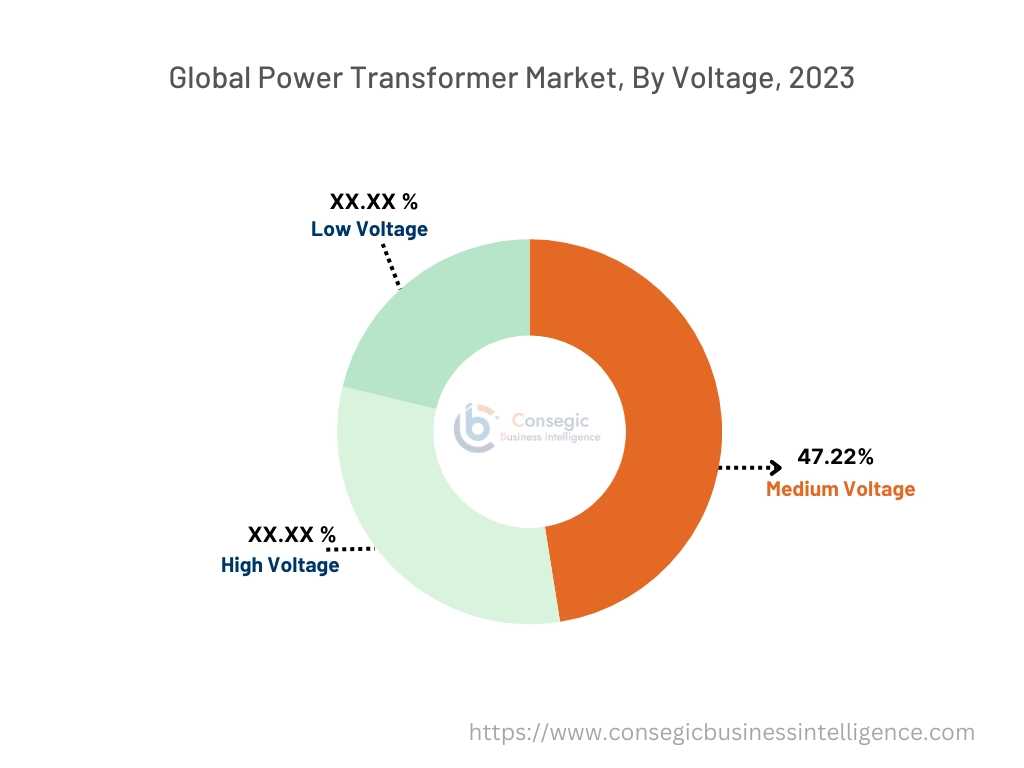
By Application :
Based on application, the market is segmented into residential, commercial, industrial, and others.
Trends in the Application:
- There is a strong focus on improving the energy efficiency of residential transformers. Advances in materials and design help reduce energy losses and operational costs, benefiting homeowners through lower electricity bills.
- Commercial power transformers are increasingly equipped with advanced cooling systems to handle high power loads and varying operational conditions. This tendency ensures enhanced performance and reliability in business environments.
- Industrial power transformers are increasingly customized to meet specific operational needs and withstand harsh conditions. This drift includes designing transformers with enhanced durability and high capacity to handle challenging industrial processes.
The industrial application accounted for the largest revenue share in 2023 and is anticipated to register the fastest CAGR during the forecast period.
- Industrial sectors, including manufacturing, heavy industries, and large-scale production facilities, require substantial amounts of power.
- This high requirement drives the need for robust and high-capacity transformers capable of managing and distributing large electrical loads.
- The industrial sector often requires customized transformers to meet specific operational needs, such as handling high voltages and unique environmental conditions.
- In May 2024, SOCOMEC India launched DELPHYS MX Elite+ UPS designed to perform in harsh industrial settings. This three-phased transformer is available in capacity ranging from 160-600 kVA and capable of parallel operation with up to 6 units to deliver superior performance, reliability, and cost-effectiveness.
- Thus, the industrial application of transformers due to the sector's significant power requirements is leading the power transformer market.
Regional Analysis:
The regions covered are North America, Europe, Asia Pacific, the Middle East and Africa, and Latin America.
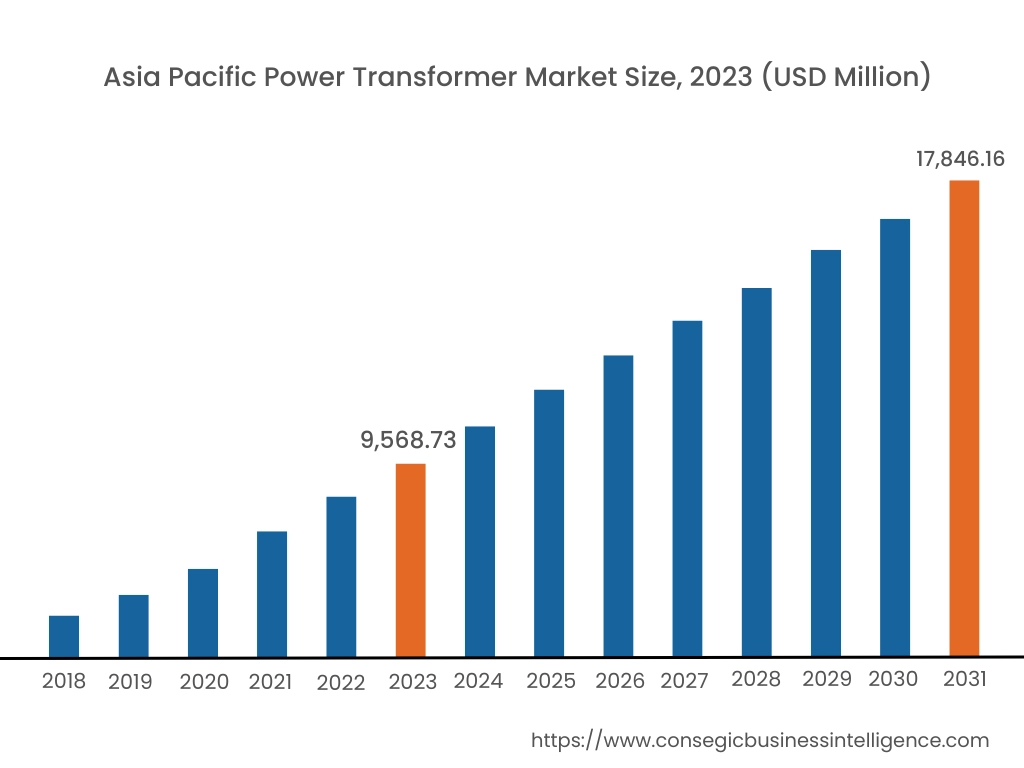
Asia Pacific region was valued at USD 9,568.73 Million in 2023. Moreover, it is projected to grow by USD 10,159.33 Million in 2024 and reach over USD 17,846.16 Million by 2031. Out of this, China accounted for the maximum revenue share of 33.5%. According to the power transformer market analysis, Asia-Pacific is experiencing rapid growth due to accelerating industrialization and urbanization. The region's economic expansion is driving the need for transformers to support new industrial facilities and infrastructure projects. Urban development and industrial growth necessitate robust power distribution systems, fueling the demand for high-capacity and reliable transformers. Additionally, the focus on integrating renewable energy sources into the grid is shaping the market, with increasing investments in renewable energy projects.
- In July 2022, Hitachi Energy (Japan) installed WindSTAR transformers with high voltage hybrid switch gear plugs to China's Tuci offshore wind power project. This solution enables the wind farm to operate reliably at a 66kV voltage level, optimizing the local energy structure. The transformers played a key role in facilitating the transfer of electricity between different countries in the region.
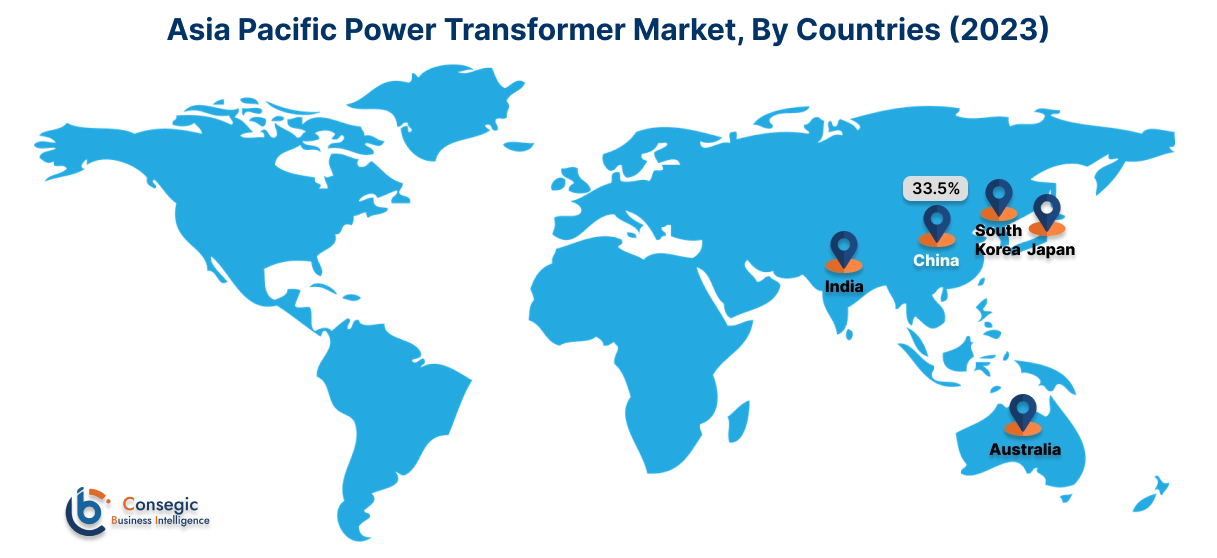
North America is estimated to reach over USD 8,962.33 Million by 2031 from a value of USD 5,146.20 Million in 2023 and is projected to grow by USD 5,432.75 Million in 2024. In North America, the power transformer market is characterized by a strong focus on technological innovation and infrastructure modernization. The region is at the forefront of adopting advanced transformer technologies, including smart grids and digital monitoring systems, which enhance operational efficiency and grid stability. Significant investments are being made to upgrade aging infrastructure to ensure reliable power delivery and meet growing demand. The industrial sector, with its diverse range of activities from manufacturing to utilities, is a major driver of the market, reflecting the region's robust industrial base.
Europe's power transformer market is heavily influenced by the region's commitment to renewable energy and stringent environmental regulations. The integration of renewable energy sources has led to an increased need for transformers that can manage variable power outputs and maintain grid stability.
In Latin America, the market is largely driven by infrastructure development and efforts to enhance energy access. The region's investment in large-scale infrastructure projects, including energy generation and transmission, is creating a substantial drift towards these transformers.
The power transformer market in the Middle East and Africa is shaped by significant investments in the energy sector and infrastructure development. The region's focus on expanding its energy capabilities, including both traditional and renewable energy projects, is driving the need for high-capacity transformers.
Top Key Players & Market Share Insights:
The power transformer market is highly competitive with major players providing energy transition to the national and international markets. Key players are adopting several strategies in research and development (R&D), product innovation, and end-user launches to hold a strong position in the market. Key players in the power transformer industry include-
- Siemens Energy AG (Germany)
- Hitachi Energy Ltd. (Switzerland)
- Mitsubishi Electric Corporation (Japan)
- Toshiba Energy Systems & Solutions Corporation (Japan)
- Eaton Corporation plc (Ireland)
- Hyosung Heavy Industries Corporation (South Korea)
- Crompton Greaves Consumer Electricals Limited (India)
- Weg S.A. (Brazil)
- SGB-SMIT Group (Germany)
- GE Grid Solutions, LLC (US)
- Schneider Electric SE(France)
- SPX Transformer Solutions, Inc. (US)
- Hyundai Electric & Energy Systems Co., Ltd. (South Korea)
- Bharat Heavy Electricals Limited (BHEL) (India)
- Fuji Electric Co., Ltd. (Japan)
- Nissin Electric Co., Ltd. (Japan)
- Wilson Power Solutions Ltd. (United Kingdom)
Recent Industry Developments :
Product Launches:
- In May 2024, SOCOMEC India launched DELPHYS MX Elite+ UPS designed to perform in harsh industrial settings. This three-phased transformer is available in capacity ranging from 160-600 kVA and capable of parallel operation with up to 6 units to deliver superior performance, reliability, and cost-effectiveness.
- In November 2023, Hitachi Energy launched Liquid-filled transformers with transient voltage Protection (TVP) technology. This solution is designed to protect distribution transformers catering to the harsh conditions of the industry.
Product Enhancement:
- In February 2024, Hitachi Energy enhanced its WindSTAR transformer with 66kV and natural ester for offshore wind applications. These transformers are designed for energy efficiency and utilize biodegradable insulating fluids. This enhancement enables them to be deployed in large and powerful wind turbines, resulting in reduced electricity loss.
Investment:
- In September 2024, Hitachi Energy invests over USD 200 million to significantly enhance its operations in Brazil. This investment includes the expansion and modernization of Guarulhos' transformer factory in São Paulo and the construction of a state-of-the-art greenfield transformer manufacturing facility.
Collaboration:
- In January 2023, ABB collaborated with OKTO GRID to optimize safety, and efficiency, and enhance reliable power supplies. This collaboration aimed at providing ABB's electrification, digitalization, and industry knowledge to enhance the development of OKTO Grid's solution.
Power Transformer Market Report Insights :
| Report Attributes | Report Details |
| Study Timeline | 2018-2031 |
| Market Size in 2031 | USD 43,612.31 Million |
| CAGR (2024-2031) | 7.7% |
| By Type |
|
| By Cooling Type |
|
| By Phase |
|
| By Voltage |
|
| By Application |
|
| By Region |
|
| Key Players |
|
| North America | U.S. Canada Mexico |
| Europe | U.K. Germany France Spain Italy Russia Benelux Rest of Europe |
| APAC | China South Korea Japan India Australia ASEAN Rest of Asia-Pacific |
| Middle East and Africa | GCC Turkey South Africa Rest of MEA |
| LATAM | Brazil Argentina Chile Rest of LATAM |
| Report Coverage |
|
Key Questions Answered in the Report
What is a power transformer? +
A power transformer is an electrical device in the electrical power system that enables the efficient transfer of electrical energy between different voltage levels without altering the frequency. It operates on the principle of electromagnetic induction and is designed to either increase or decrease the voltage in the power transmission network.
How big is the power transformer market? +
The Power Transformer Market size is estimated to reach over USD 43,612.31 Million by 2031 from a value of USD 24,169.05 Million in 2023 and is projected to grow by USD 25,589.22 Million in 2024, growing at a CAGR of 7.7% from 2024 to 2031.
What is the key market trend? +
Industrial power transformers are increasingly customized to meet specific operational needs and withstand harsh conditions. This trend includes designing transformers with enhanced durability and high capacity to handle challenging industrial processes.
Who are the major key players in the power transformer market? +
The major key players in power transformer market are Siemens Energy AG (Germany), GE Grid Solutions, LLC (US), Schneider Electric SE (France), Mitsubishi Electric Corporation (Japan), Toshiba Energy Systems & Solutions Corporation (Japan), Hitachi Energy Ltd. (Switzerland), Eaton Corporation plc (Ireland), Hyosung Heavy Industries Corporation (South Korea), Crompton Greaves Consumer Electricals Limited (India), SPX Transformer Solutions, Inc. (US), Hyundai Electric & Energy Systems Co., Ltd. (South Korea), Bharat Heavy Electricals Limited (BHEL) (India), Fuji Electric Co., Ltd. (Japan) Nissin Electric Co., Ltd. (Japan), Weg S.A. (Brazil), SGB-SMIT Group (Germany), Wilson Power Solutions Ltd. (United Kingdom) and others.
